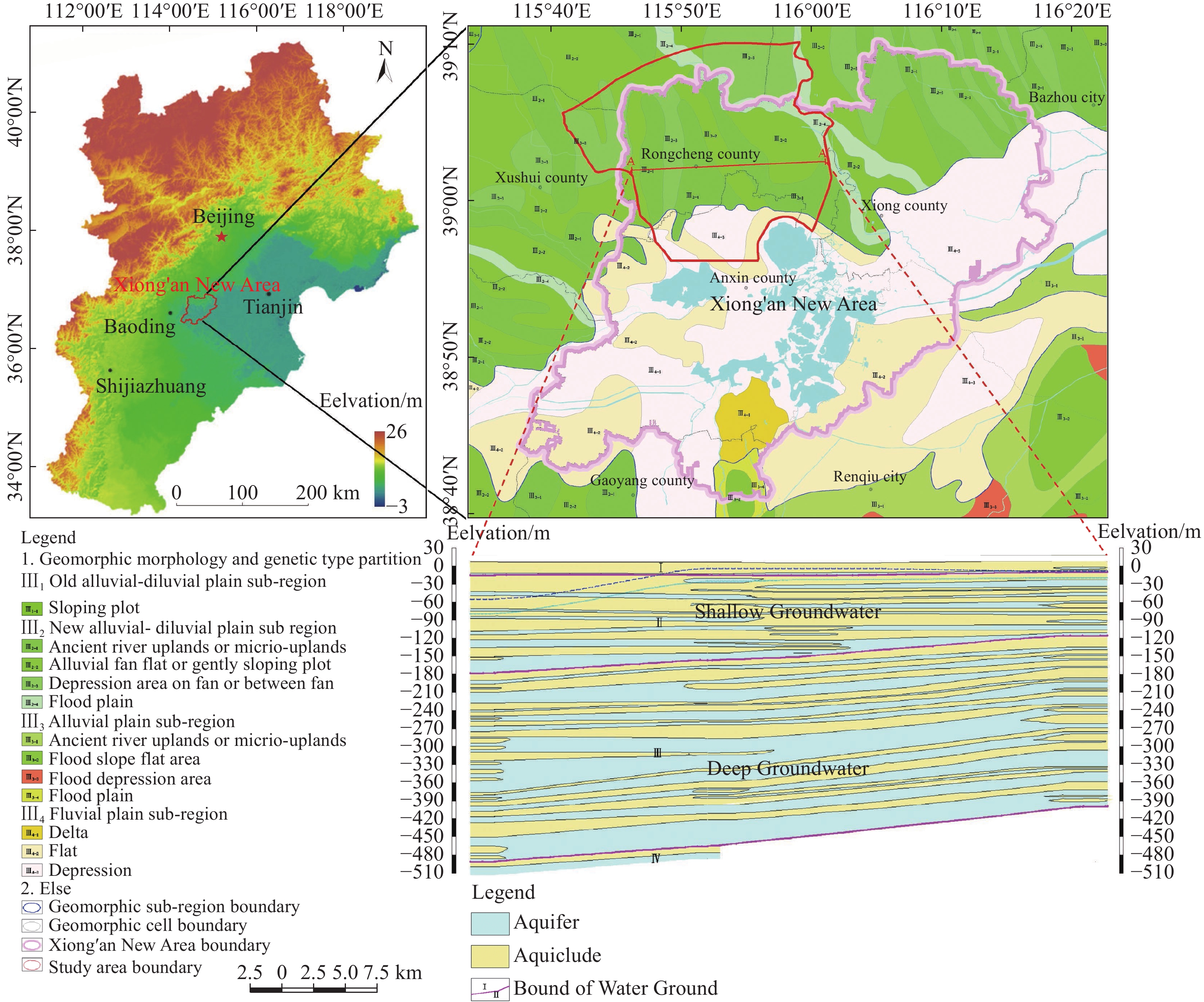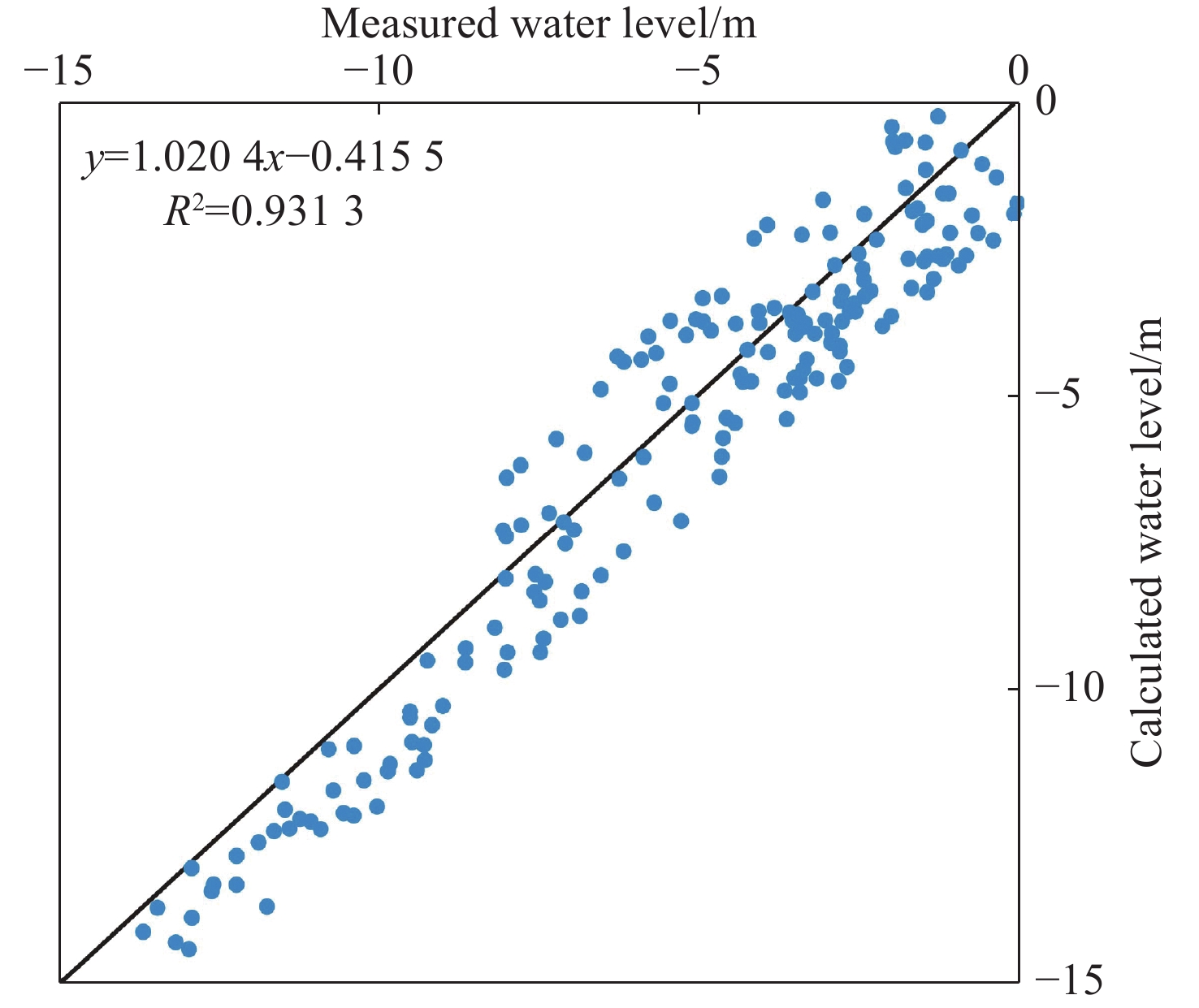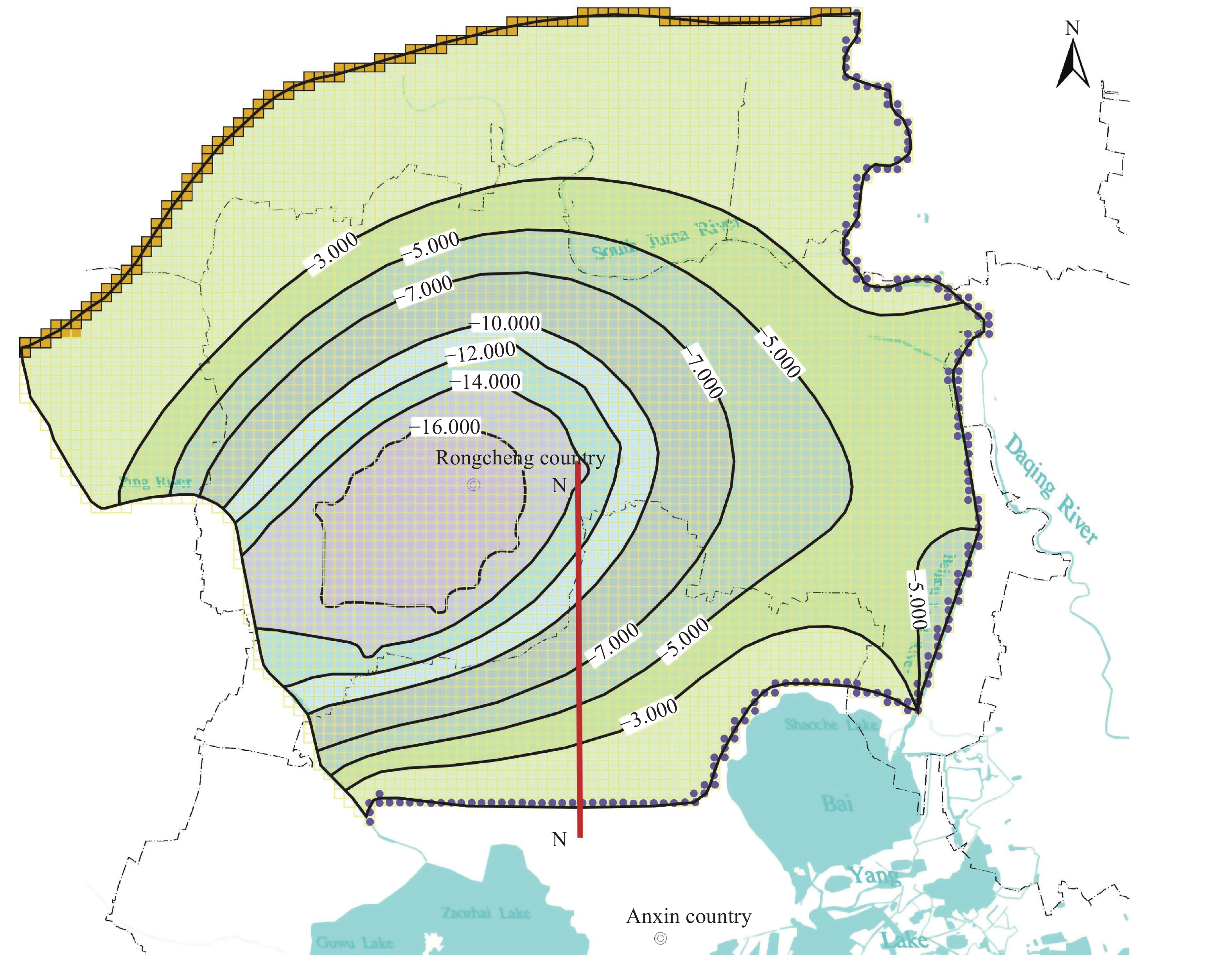Influence of underground space development mode on the groundwater flow field in Xiong’an new area
-
Abstract:
The degree and scale of underground space development are growing with the continuous advancement of urbanization in China. The lack of research on the change of the groundwater flow field before and after the development of underground space has led to various problems in the process of underground space development and operation. This paper took the key development zone of the Xiong’an New Area as the study area, and used the Groundwater modeling system software (GMS) to analyse the influence on the groundwater flow field under the point, line, and surface development modes. The main results showed that the underground space development would lead to the expansion and deepening of the cone of depression in the aquifer. The groundwater level on the upstream face of the underground structure would rise, while the water level on the downstream face would drop. The “line” concurrent development has the least impact on the groundwater flow field, and the maximum rise of water level on the upstream side of the underground structure is expected to be approximately 3.05 m. The “surface” development has the greatest impact on the groundwater flow field, and the maximum rise of water level is expected to be 7.17 m.
-
Key words:
- Xiong’an new area /
- Groundwater flow field /
- Underground space /
- GMS
-

-
Table 1. Initial hydraulic properties
No. Stratum and lithology Layer Horizontal hydraulic conductivity (m/d) Vertical hydraulic conductivity (m/d) Specific yield 1 Landfill Unsaturated zone 8.35e-05 3.77e-05 0.027 5 2 Alluvial pluvial soil Unsaturated zone 2.3e-03 7.4e-03 0.027 5 3 Alluvial lacustrine soil Unsaturated zone 5.1e-03 7.6e-03 0.027 5 4 Clay + silt Unsaturated zone 3.0e-03 5.9e-03 0.037 5 5 Clayey sand Unsaturated zone 1.0e-04 1.6e-04 0.037 5 6 Find sand + silt Unconfined aquifer 3.16 3.16 0.04 7 Clay + silt Low-permeability aquifer 9.5e-03 7.30e-03 0.037 5 8 Find sand + silt Confined aquifer 0.907 0.907 0.047 5 9 Clayey soil Impermeable layer 1.0e-04 1.6e-04 0.027 5 10 Find sand + Silt + Medium sand Confined aquifer 0.777 6 0.777 6 0.07 11 Clayey soil Impermeable layer 2.8e-03 3.9e-04 0.027 5 12 Clayey soil Impermeable layer 2.1e-04 3.2e-04 0.027 5 13 Find sand + Silt + Medium sand Confined aquifer 2.592 2.592 0.095 14 Clayey soil Impermeable layer 1.5e-02 3.7e-03 0.027 5 15 Find sand + Medium sand Confined aquifer 2.592 2.592 0.095 16 Clayey soil Impermeable layer 8.5e-05 1.6e-04 0.027 5 17 Find sand + Medium sand Confined aquifer 2.592 2.592 0.095 18 Clayey soil Impermeable layer 1.9e-04 3.6e-04 0.027 5 Table 2. List of data of the influences on groundwater exerted by different modes of underground space development
Development modes Increasing amplitude (m) Average (m) Decreasing amplitude (m) Average (m) Overall N-N Section N-N Section Overall N-N Section N-N Section Point 3.5 3.24 1.81 3.6 3.34 2.19 Line-down-flow 3.05 3.04 1.64 3.47 2.84 2 Line-cross-closure 5.3 4.85 2.73 4.95 4.74 3.39 Surface 7.17 6.67 4.76 7.67 7.17 4.69 Development modes Funnel extent (km) Decreasing amplitude in the center (m) Hydraulic gradient Extent of influence (km) N-N Section Overall N-N Section Overall N-N Section N-N Section Point 3.40 3.92 3.34 5.45 3.03 4.00 Line-down-flow 3.00 3.13 2.84 4.81 2.01 7.00 Line-cross-closure 5.50 5.04 4.75 8.33 3.92 5.80 Surface 7.70 >8 6.96 13.46 12.82 >8 -
Attard G, Rossier Y, Eisenlohr L. 2017. Underground structures increasing the intrinsic vulnerability of urban groundwater: Sensitivity analysis and development of an empirical law based on a groundwater age modelling approach. Journal of Hydrology, 552: 460−473. DOI:10.1016/j.jhydrol.2017.07.013.
Attard G, Winiarski T, Rossier Y, et al. 2016. Review: Impact of underground structures on the flow of urban groundwater. Hydrogeology Journal, 24: 5−19. DOI:10.1007/s10040-015-1317-3.
Bobylev N. 2009. Mainstreaming sustainable development into a city’s Master plan: A case of Urban Underground Space use. Land Use Policy, 26: 1128−1137. DOI:10.1016/j.landusepol.2009.02.003.
Borgia A, Cattaneo L, Marconi D, et al. 2011. Using a MODFLOW grid, generated with GMS, to solve a transport problem with TOUGH2 in complex geological environments: The intertidal deposits of the Venetian Lagoon. Computers & Geosciences, 37: 783−790. DOI:10.1016/j.cageo.2010.11.007.
Chandrasekharan H, Tadi SG, Sarangi A, et al. 2005. Urbanization effects on the groundwater status of Delhi, India. In: Savic DA, Marino MA, Savenije HG, Bertoni JC, editors. Sustainable Water Management Solutions for Large Cities: 293, 294-298.
Chen Y, Liu G, Huang X, et al. 2020. Development of a surrogate method of groundwater modeling using gated recurrent unit to improve the efficiency of parameter auto-calibration and global sensitivity analysis. Journal of Hydrology: 125726. DOI:10.1016/j.jhydrol.2020.125726.
Chen ZL, Chen JY, Liu H, et al. 2018. Present status and development trends of underground space in Chinese cities: Evaluation and analysis. Tunnelling and Underground Space Technology, 71: 253−270. (in Chinese) DOI:10.1016/j.tust.2017.08.027.
Chi G, Su X, Lyu H, et al. 2021. Simulating the shallow groundwater level response to artificial recharge and storage in the Plain area of the Daqing River Basin, China. Sustainability, 13: 5626. DOI:10.3390/su13105626.
Cui JQ, Broere W, Lin D. 2021. Underground space utilisation for urban renewal. Tunnelling and Underground Space Technology, 108: 103726. DOI:10.1016/j.tust.2020.103726.
De Caro M, Crosta GB, Previati A. 2020. Modelling the interference of underground structures with groundwater flow and remedial solutions in Milan. Engineering Geology, 272: 105652. DOI:10.1016/j.enggeo.2020.105652.
Dong L, Zhang J. 2021. Predicting polycyclic aromatic hydrocarbons in surface water by a multiscale feature extraction-based deep learning approach. Science of the Total Environment: 799. DOI:10.1016/j.scitotenv.2021.149509.
Foster S, Garduno H, Evans R, et al. 2004. Quaternary aquifer of the North China Plain — assessing and achieving groundwater resource sustainability. Hydrogeology Journal, 12: 81−93. DOI:10.1007/s10040-003-0300-6.
Han JC, Huang Y, Li Z, et al. 2016. Groundwater level prediction using a SOM-aided stepwise cluster inference model. Journal of Environmental Management, 182: 308−321. DOI:10.1016/j.jenvman.2016.07.069.
He DF, Shan SQ, Zhang YY, et al. 2018. 3-D geologic architecture of Xiong’an New Area: Constraints from seismic reflection data. Science China Earth Sciences, 48(9): 1207−1222.
Hu ZH, Li XZ, Zhao XB, et al. 2008. Numerical analysis of factors affecting the range of heat transfer in earth surrounding three subways. Journal of China University of Mining and Technology, 18: 67−71. DOI:10.1016/S1006-1266(08)60015-2.
Li HP, Wickham JD, Bushley K, et al. 2020. New approaches in urban forestry to minimize invasive species impacts: The case of Xiongan New Area in China. Insects: 11. DOI:10.3390/insects11050300.
Li R, Zhang J, Krebs P. 2021. Consumption- and income-based sectoral emissions of Polycyclic Aromatic Hydrocarbons in China from 2002 to 2017. Environmental Science & Technology, 55: 3582−3592. DOI:10.1021/acs.est.0c08119.
Li X, Ye SY, Wei AH, et al. 2017. Modelling the response of shallow groundwater levels to combined climate and water-diversion scenarios in Beijing-Tianjin-Hebei Plain, China. Hydrogeology Journal, 25: 1733−1744. DOI:10.1007/s10040-017-1574-4.
Li XG, Yuan DJ. 2012. Response of a double-decked metro tunnel to shield driving of twin closely under-crossing tunnels. Tunnelling and Underground Space Technology, 28: 18−30. DOI:10.1016/j.tust.2011.08.005.
Liu FY, Cui JH, Chen LJ, et al. 2009. A view on geomorphologic zonalization of north china plain. Geography and Geo-Information Science, 25(4): 100−103.
Ma Y, Li HQ, Zhang J, et al. 2020. Geophysical technology for underground space exploration in Xiongan New Area. Acta Geoscientica Sinica, 41(4): 535−542.
Ma Z, Xia YB, Wang XD, et al. 2019. Integration of Engineering Geological Investigation Data and Construction of a 3D Geological Structure Model in the Xiong’an New Area. Geology in China, 46: 123−138.
Makungo R, Odiyo JO. 2017. Estimating groundwater levels using system identification models in Nzhelele and Luvuvhu areas, Limpopo Province, South Africa. Physics and Chemistry of the Earth, Parts A/B/C, 100: 44−50. DOI:10.1016/j.pce.2017.01.019.
Melaku ND, Wang J. 2019. A modified SWAT module for estimating groundwater table at Lethbridge and Barons, Alberta, Canada. Journal of Hydrology, 575: 420−431. DOI:10.1016/j.jhydrol.2019.05.052.
Mengistu HA, Demlie MB, Abiye TA, et al. 2019. Conceptual hydrogeological and numerical groundwater flow modelling around the Moab Khutsong deep gold mine, South Africa. Groundwater for Sustainable Development, 9: 100266. DOI:10.1016/j.gsd.2019.100266.
Paris A, Teatini P, Venturini S, et al. 2010. Hydrological effects of bounding the Venice (Italy) industrial Harbor by a protection cutoff wall: Modeling study. Journal of Hydrologic Engineering, 15: 882−891. DOI:10.1061/(ASCE)HE.1943-5584.0000258.
Qiao YK, Peng FL. 2016. Master planning for underground space in Luoyang: A case of a representative historic city in China. Procedia Engineering, 165: 119−125. DOI:10.1016/j.proeng.2016.11.743.
Qin H, Cao G, Kristensen M, et al. 2013. Integrated hydrological modeling of the North China Plain and implications for sustainable water management. Hydrology and Earth System Sciences, 17: 3759−3778. DOI:10.5194/hess-17-3759-2013.
Ricci G, Enrione R, Eusebio A, et al. 2007. Numerical modelling of the interference between underground structures and aquifers in urban environment. The Turin subway — Line 1. Available on https://www.researchgate.net/publication/283166768.
Rwanga S, Ndambuki J. 2020. Solving groundwater problems fraught with uncertain recharge: An application to Central Limpopo, South Africa. Groundwater for Sustainable Development, 10: 100305. DOI:10.1016/j.gsd.2019.100305.
Sathe SS, Mahanta C. 2019. Groundwater flow and arsenic contamination transport modeling for a multi aquifer terrain: Assessment and mitigation strategies. Journal of Environmental Management, 231: 166−181. DOI:10.1016/j.jenvman.2018.08.057.
Serrano-Juan A, Pujades E, Vázquez-Suñè E, et al. 2018. Integration of groundwater by-pass facilities in the bottom slab design for large underground structures. Tunnelling and Underground Space Technology, 71: 231−243. DOI:10.1016/j.tust.2017.07.020.
Singha S, Pasupuleti S, Singha SS, et al. 2020. Effectiveness of groundwater heavy metal pollution indices studies by deep-learning. Journal of Contaminant Hydrology, 235: 103718. DOI:10.1016/j.gsd.2019.100245.
Uddin MG, Moniruzzaman M, Quader MA, et al. 2018. Spatial variability in the distribution of trace metals in groundwater around the Rooppur nuclear power plant in Ishwardi, Bangladesh. Groundwater for Sustainable Development, 7: 220−231. DOI:10.1016/j.gsd.2018.06.002.
Wang C, Masoudi A, Wang M, et al. 2021. Land-use types shape soil microbial compositions under rapid urbanization in the Xiong’an New Area, China. Science of the Total Environment, 777: 145976. DOI:10.1016/j.scitotenv.2021.145976.
Wang GL, Liu ZM, Chen H, et al. 2010. Compilation of technical methods for investigation and evaluation of groundwater resources. Beijing, Geological Publishing House.
Wu Y. 2003. Mechanism analysis of hazards caused by the interaction between groundwater and geo-environment. Environmental Geology, 44: 811−819. DOI:10.1007/s00254-003-0819-9.
Xie SL, Su YB, Xu WH, et al. 2019. The effect of habitat changes along the urbanization gradient for breeding birds: An example from the Xiong’an New Area. PeerJ, 7(10): 7961. DOI:10.7717/peerj.7961.
Xu HQ, Wang MY, Shi TT, et al. 2018. Prediction of ecological effects of potential population and impervious surface increases using a remote sensing based ecological index (RSEI). Ecological Indicators, 93: 730−740. DOI:10.1016/j.ecolind.2018.05.055.
Xu YS, Shen SL, Du YJ, et al. 2013. Modelling the cutoff behavior of underground structure in multi-aquifer-aquitard groundwater system. Natural Hazards, 66: 731-748. Available on https://link.springer.com/article/10.1007/s11069-012-0512-y
Xu YS, Ma L, Shen SL, et al. 2012. Evaluation of land subsidence by considering underground structures that penetrate the aquifers of Shanghai, China. Hydrogeology Journal, 20: 1623−1634. DOI:10.1007/s10040-012-0892-9.
Yang W, Wang Z, Hua P, et al. 2021. Impact of green infrastructure on the mitigation of road-deposited sediment induced stormwater pollution. Science of the Total Environment: 770.
Yang W, Zhang J. 2021. Assessing the performance of gray and green strategies for sustainable urban drainage system development: A multi-criteria decision-making analysis. Journal of Cleaner Production: 293. DOI:10.1016/j.jclepro.2021.126191.
Zhu X, Wang G, Wang X, et al. 2022. Hydrogeochemical and isotopic analyses of deep geothermal fluids in the Wumishan formation in Xiong’an New Area, China. Lithosphere: 2021.
Zou WY, Yin SQ, Wang WT. 2021. Spatial interpolation of the extreme hourly precipitation at different return levels in the Haihe River basin. Journal of Hydrology, 598: 126273. DOI:10.1016/j.jhydrol.2021.126273.
-




 下载:
下载:





